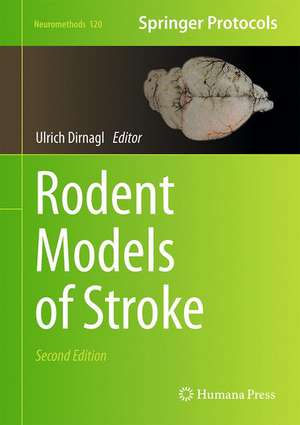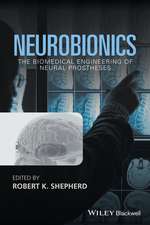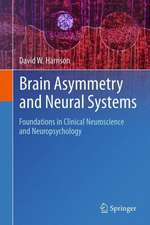Rodent Models of Stroke: Neuromethods, cartea 120
Editat de Ulrich Dirnaglen Limba Engleză Hardback – 30 aug 2016
This second edition provides updated and expanded chapters that critically address the issues or rodent stroke modeling, from choosing the model and outcome measures, designing the experiment, conducting and analyzing it, to reporting it in a scientific publication. Rodent Models of Stroke, Second Edition aims to help its readers understand the limitations and the opportunities of modeling stroke in rodents and enable them to conduct experiments which will not only improve our understanding of the pathophysiology of this devastating disorder but also serve as the basis for developing new highly effective treatments. Written for the popular Neuromethods series, chapters include the kind of detail and key implementation advice that ensures successful results in the laboratory.
Authoritative and practical, Rodent Models of Stroke, Second Edition provides authoritative reviews of the most commonly used, well-honed approachesin the field today.
Authoritative and practical, Rodent Models of Stroke, Second Edition provides authoritative reviews of the most commonly used, well-honed approachesin the field today.
| Toate formatele și edițiile | Preț | Express |
|---|---|---|
| Paperback (2) | 888.32 lei 6-8 săpt. | |
| Humana Press Inc. – 23 aug 2016 | 888.32 lei 6-8 săpt. | |
| Springer – 21 apr 2018 | 891.45 lei 6-8 săpt. | |
| Hardback (2) | 651.84 lei 6-8 săpt. | |
| Humana Press Inc. – 8 iul 2010 | 651.84 lei 6-8 săpt. | |
| Springer – 30 aug 2016 | 655.13 lei 6-8 săpt. |
Din seria Neuromethods
- 5%
 Preț: 347.58 lei
Preț: 347.58 lei - 15%
 Preț: 659.53 lei
Preț: 659.53 lei - 15%
 Preț: 665.08 lei
Preț: 665.08 lei - 18%
 Preț: 986.63 lei
Preț: 986.63 lei - 18%
 Preț: 953.03 lei
Preț: 953.03 lei - 18%
 Preț: 955.25 lei
Preț: 955.25 lei - 20%
 Preț: 1129.39 lei
Preț: 1129.39 lei - 20%
 Preț: 1252.07 lei
Preț: 1252.07 lei - 18%
 Preț: 1291.45 lei
Preț: 1291.45 lei - 15%
 Preț: 652.31 lei
Preț: 652.31 lei - 18%
 Preț: 955.70 lei
Preț: 955.70 lei - 23%
 Preț: 705.40 lei
Preț: 705.40 lei - 18%
 Preț: 973.38 lei
Preț: 973.38 lei - 18%
 Preț: 964.86 lei
Preț: 964.86 lei - 18%
 Preț: 968.03 lei
Preț: 968.03 lei - 15%
 Preț: 662.95 lei
Preț: 662.95 lei - 15%
 Preț: 646.43 lei
Preț: 646.43 lei - 15%
 Preț: 649.71 lei
Preț: 649.71 lei -
 Preț: 395.29 lei
Preț: 395.29 lei - 19%
 Preț: 580.68 lei
Preț: 580.68 lei - 19%
 Preț: 584.13 lei
Preț: 584.13 lei - 19%
 Preț: 566.41 lei
Preț: 566.41 lei - 15%
 Preț: 652.17 lei
Preț: 652.17 lei - 15%
 Preț: 655.13 lei
Preț: 655.13 lei - 18%
 Preț: 1009.58 lei
Preț: 1009.58 lei - 18%
 Preț: 959.36 lei
Preț: 959.36 lei - 15%
 Preț: 652.49 lei
Preț: 652.49 lei - 15%
 Preț: 649.54 lei
Preț: 649.54 lei - 15%
 Preț: 649.87 lei
Preț: 649.87 lei - 15%
 Preț: 650.19 lei
Preț: 650.19 lei - 15%
 Preț: 648.42 lei
Preț: 648.42 lei - 18%
 Preț: 1039.22 lei
Preț: 1039.22 lei - 18%
 Preț: 963.15 lei
Preț: 963.15 lei
Preț: 655.13 lei
Preț vechi: 770.73 lei
-15% Nou
Puncte Express: 983
Preț estimativ în valută:
125.37€ • 136.14$ • 105.31£
125.37€ • 136.14$ • 105.31£
Carte tipărită la comandă
Livrare economică 22 aprilie-06 mai
Preluare comenzi: 021 569.72.76
Specificații
ISBN-13: 9781493956180
ISBN-10: 1493956183
Pagini: 340
Ilustrații: XII, 338 p. 61 illus., 54 illus. in color.
Dimensiuni: 178 x 254 x 26 mm
Greutate: 0.83 kg
Ediția:2nd ed. 2016
Editura: Springer
Colecția Humana
Seria Neuromethods
Locul publicării:New York, NY, United States
ISBN-10: 1493956183
Pagini: 340
Ilustrații: XII, 338 p. 61 illus., 54 illus. in color.
Dimensiuni: 178 x 254 x 26 mm
Greutate: 0.83 kg
Ediția:2nd ed. 2016
Editura: Springer
Colecția Humana
Seria Neuromethods
Locul publicării:New York, NY, United States
Cuprins
From Bedside to Bench: How Clinical Reality Should Instruct Stroke Modeling.- How to Avoid Bumping into the Translational Roadblock.- Modeling Focal Cerebral Ischemia in Rodents: Introduction and Overview.- Focal Cerebral Ischemia in the Mouse and Rat by Intraluminal Suture.- Focal Ischemia Models: Middle Cerebral Artery Occlusion Induced by Electrocoagulation, Occluding devices and Endothelin-1.- Mouse Model of in situ Thromboembolic Stroke and Reperfusion.- Photochemical Models of Focal Brain Ischemia.- Housing in an Enriched Environment – A Tool to Study Functional Recovery after Experimental Stroke.- Modeling Risk Factors and Confounding Effects in Stroke.- Effect of Anesthesia in Stroke Models.- Non-invasive Brain Imaging in Small Animal Stroke Models: MRI, PET and SPECT.- Non-invasive Optical Imaging in Rodent Models of Stroke .- Behavioral Testing in Rodent Models of Stroke, Part I.- Behavioral Testing in Rodent Models of Stroke –Part II.- Combining Classical Comprehensive With Ethological Based, High Throughput Automated Behavioral Phenotyping for Rodent Models of Stroke.- Histology and Infarct Volume Determination in Rodent Models of Stroke.- Ethics of Modeling of Cerebral Ischemia in Small Animals.- Quality Control and Standard Operating Procedures.- Statistics in Experimental Stroke Research: From Sample Size Calculation to Data Description and Significance Testing.- Complexities, Confounders, and Challenges in Experimental Stroke Research: A Checklist for Researchers and Reviewers.
Textul de pe ultima copertă
This second edition provides updated and expanded chapters that critically address the issues or rodent stroke modeling, from choosing the model and outcome measures, designing the experiment, conducting and analyzing it, to reporting it in a scientific publication. Rodent Models of Stroke, Second Edition aims to help its readers understand the limitations and the opportunities of modeling stroke in rodents and enable them to conduct experiments which will not only improve our understanding of the pathophysiology of this devastating disorder but also serve as the basis for developing new highly effective treatments. Written for the popular Neuromethods series, chapters include the kind of detail and key implementation advice that ensures successful results in the laboratory.
Authoritative and practical, Rodent Models of Stroke, Second Edition provides authoritative reviews of the most commonly used, well-honed approaches in the field today.
Authoritative and practical, Rodent Models of Stroke, Second Edition provides authoritative reviews of the most commonly used, well-honed approaches in the field today.
Caracteristici
Includes cutting-edge methods and protocols Provides step-by-step detail essential for reproducible results Contains key notes and implementation advice from the experts
Recenzii
From the reviews:
“Rodent Models of Stroke by U. Dirnagl is simply the best ischemia book on principles, theory, protocols, and techniques which has been written over the past 25 years. … This book is aimed at a broad audience on ischemia research including graduate students, postgraduate scholars, junior faculty, and senior seasoned investigators. … In short, this is an ideal textbook for being a primer or a detailed reference to refer to. I highly recommend it.” (Joseph J. Grenier, Amazon.com, September, 2013)
“Rodent Models of Stroke by U. Dirnagl is simply the best ischemia book on principles, theory, protocols, and techniques which has been written over the past 25 years. … This book is aimed at a broad audience on ischemia research including graduate students, postgraduate scholars, junior faculty, and senior seasoned investigators. … In short, this is an ideal textbook for being a primer or a detailed reference to refer to. I highly recommend it.” (Joseph J. Grenier, Amazon.com, September, 2013)

















